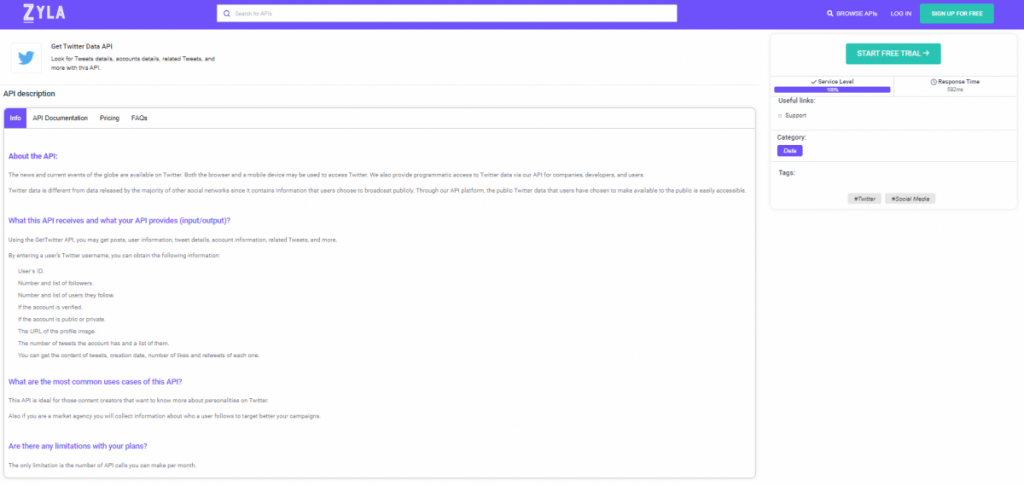When working with Twitter data, it is often essential to gather information about specific users. With the help of a Twitter API, you can streamline the process of searching for and retrieving valuable user data. In this article, we will explore how to effectively search for information about users using a Twitter API and the potential use cases for this functionality.

A Twitter API Grants You Access To Needed Data
User Profile Data: An API allows you to access various details about a user’s profile, including their username, bio, location, follower count, and more. By leveraging this API, developers can easily retrieve user-specific information for analysis, research, or personalized user experiences. This data can be particularly useful for social media analytics, targeted marketing campaigns, or user behavior studies.
Social Network Analysis: With the user search functionality provided by a Twitter API, developers can gather information about a user’s followers, the accounts they follow, and their overall network connections. This data is valuable for social network analysis, influencer identification, or identifying potential collaborations. By understanding the connections and relationships between users, businesses can develop effective social media strategies and partnerships.
Sentiment Analysis and Opinion Mining: The Twitter API can help you access user-generated content, including tweets, to perform sentiment analysis and opinion mining. By analyzing the language and sentiment expressed in tweets from specific users, you can gain insights into their attitudes, preferences, or opinions on various topics. This functionality is particularly useful for market research, brand reputation management, or understanding public sentiment toward specific individuals or organizations.
User Activity Tracking: Using a data API, you can track and monitor a user’s activity on the platform. This includes retrieving a user’s recent tweets, likes, retweets, and replies. By analyzing a user’s engagement patterns, content preferences, or interaction behavior, businesses can tailor their marketing strategies, personalize user experiences, or identify potential brand ambassadors.
User-Generated Content Curation: The user search functionality of a Twitter API enables you to curate user-generated content for specific purposes. For example, you can search for tweets that mention a particular user, topic, or hashtag, and gather relevant content for further analysis or display. This feature is valuable for content curation, social media campaigns, or event tracking.
Check Get Twitter Data API
When it comes to accessing Twitter data efficiently, the Get Twitter Data API by Zyla Labs is a fantastic choice. This API seamlessly integrates into your applications, providing real-time updates on tweets, users, and trends. With its versatile data retrieval options based on keywords, users, or locations, the Get Twitter Data API caters to a wide range of use cases.

Whether you’re a social media analyst tracking trends, a news organization gathering real-time tweets, a marketer targeting specific audiences, or a developer creating innovative Twitter applications, the Get Twitter Data API offers valuable insights to enhance your strategies.
How To Use It?
- First, go to Get Twitter Data API and press the “START FREE TRIAL” button.
- Then, you’ll be able to use the API after joining Zyla API Hub!
- Send a request to the API in the endpoint needed.
- Finally, you will receive an API response.
The API provides six endpoints for working with Twitter data: /user_details, /tweets_per_user, /who_is_the_user_following, /user_followers, /tweet_details, and /search_tweets_by_sentences/words.
/user_detailsgives information about a user, such as their username, bio, and location./tweets_per_userthis endpoint gets a list of tweets for a user./who_is_the_user_followingwith this, you will retrieve a list of users that a user is following./user_followersis useful to get a list of users that are following a user./tweet_detailsendpoint gives information about a tweet, such as its text, timestamp, and location./search_tweets_by_sentences/wordsendpoint searches for tweets that contain a specific sentence or word.
These endpoints can be useful to get information about users, tweets, and their relationships. This information can be used for a variety of purposes, such as social media analytics, marketing research, and customer support.
For example, if you try the User Details endpoint to get data on Elon Musk, you will get a response like this:
{
"creation_date": "Tue Jun 02 20:12:29 +0000 2009",
"user_id": "44196397",
"username": "elonmusk",
"name": "Elon Musk",
"follower_count": 145114901,
"following_count": 339,
"favourites_count": 26451,
"is_private": false,
"is_verified": false,
"is_blue_verified": true,
"location": "",
"profile_pic_url": "https://pbs.twimg.com/profile_images/1590968738358079488/IY9Gx6Ok_normal.jpg",
"profile_banner_url": "https://pbs.twimg.com/profile_banners/44196397/1576183471",
"description": "",
"external_url": null,
"number_of_tweets": 27374,
"bot": false,
"timestamp": 1243973549,
"has_nft_avatar": false,
"category": null,
"default_profile": false,
"default_profile_image": false,
"listed_count": null
}If you want to learn more, check How To Leverage A Twitter Data API To Get Business Insights

